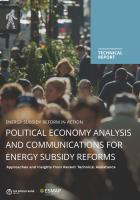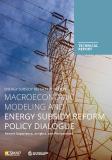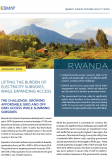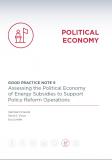Publications
This report takes stock of political economy analysis (PEA) and communications in the context of country-specific technical assistance activities supporting energy subsidy reforms that benefited from financial and technical support from ESMAP. Initiated as part of a retrospective assessment of technical assistance activities that ESMAP's Energy Subsidy Reform Facility (ESRF) has supported since its establishment, this report reviews designs and implementation approaches of World Bank–executed technical assistance activities. The assessment is based on a qualitative review of key outputs of select PEA and communications support activities carried out in the context of country grants. The report documents different approaches, assesses activity designs and outputs, and attempts to draw insights from emerging practices and substantive findings, along with making recommendations for future work. Key questions include, What practical approaches are used for providing technical and advisory support to developing-country governments for political economy assessments and communications strategies in support of energy subsidy reform efforts? What good practice examples are available for assessing political economy dimensions, using them to inform reform designs by addressing key impacts and concerns identified and conducting meaningful stakeholder engagement to explain the reform and build support?
Learn more about ESMAP's Energy Subsidy Reform Facility.
Moerenhout, Tom; Gencer, Defne; Arizu, Beatriz; Lee, Min A; Braun, Hannah. 2024. ESMAP Technical Report - Energy Subsidy Reform in Action: Political Economy Analysis and Communications for Energy Subsidy Reform - Approaches and Insights from Recent Technical Assistance. © Washington, DC: World Bank. http://hdl.handle.net/10986/41422 License: CC BY-NC 3.0 IGO.




